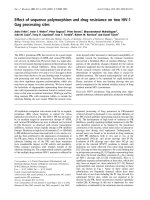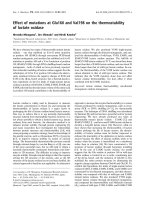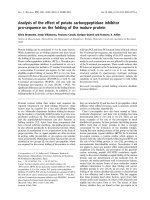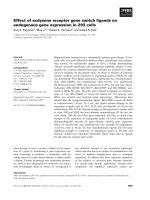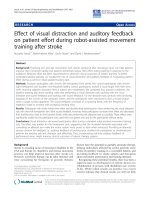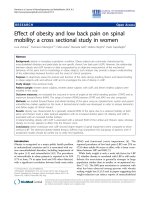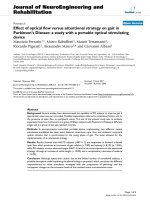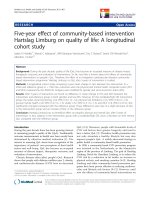Effect of four additional physical education lessons on body composition in children aged 8–13 years – a prospective study during two school years
Bạn đang xem bản rút gọn của tài liệu. Xem và tải ngay bản đầy đủ của tài liệu tại đây (637.97 KB, 8 trang )
Klakk et al. BMC Pediatrics 2013, 13:170
/>
RESEARCH ARTICLE
Open Access
Effect of four additional physical education
lessons on body composition in children aged
8–13 years – a prospective study during two
school years
Heidi Klakk1,2,7*, Mai Chinapaw3, Malene Heidemann4, Lars Bo Andersen1,6 and Niels Wedderkopp1,5
Abstract
Background: Strategies for combating increasing childhood obesity is called for. School settings have been
pointed out as potentially effective settings for prevention. The objective of this paper was to evaluate the effect of
four additional Physical Education (PE) lessons/week in primary schools on body composition and weight status in
children aged 8–13.
Methods: Children attending 2nd to 4th grade (n = 632) in 10 public schools, 6 intervention and 4 control schools,
participated in this longitudinal study during 2 school years. Outcome measures: Primary: Body Mass Index (BMI)
and Total Body Fat percentage (TBF%) derived from Dual Energy X ray Absorptiometry (DXA). Secondary: the
moderating effect of overweight/obesity (OW/OB) and adiposity based on TBF% cut offs for gender.
Results: Intervention effect on BMI and TBF% (BMI: β -0.14, 95% CI: -0.33; 0.04, TBF%: β -0.08, 95% CI:-0.65;0.49) was
shown insignificant. However, we found significant beneficial intervention effect on prevalence of OW/OB based on
BMI (OR 0.29, 95% CI: 0.11;0.72). The intervention effect on adiposity based on TBF% cut offs was borderline
significant (OR 0.64, 95% CI:0. 39; 1.05).
Conclusion: Four additional PE lessons/week at school can significantly improve the prevalence of OW/OB in
primary schoolchildren. Mean BMI and TBF% improved in intervention schools, but the difference with controls was
not significant. The intervention had a larger effect in children who were OW/OB or adipose at baseline.
Keywords: School-based intervention, BMI, DXA, Total body fat percentage, Children, Obesity prevention,
Longitudinal study
Background
The recent increase in prevalence of childhood overweight
(OW) and obesity (OB) has been a growing concern to
public health as it is linked to subsequent morbidity and
mortality both in adolescence and adulthood [1,2]. Physical activity is essential for the wellbeing and normal
growth of children and youth and plays an important role
in the prevention of OW and OB and related morbidities
[3,4]. Schools are recognized as potentially effective
* Correspondence:
1
Centre of Research in Childhood Health, Institute of Sports Science and
Clinical Biomechanics, University of Southern Denmark, Odense, Denmark
2
University College Lillebaelt, Odense, Denmark
Full list of author information is available at the end of the article
settings for public health initiatives, as they access a large
population of children and youth across a variety of ethnic
and socioeconomic groups without stigmatizing specific
subgroups of high-risk children. The World Health
Organization (WHO) specifically identified schools as a
target setting for the promotion of physical activity among
children and youth [5].
The last decades a considerable number of school-based
physical activity promotion and overweight prevention
studies have been conducted and their effectiveness on
health outcomes evaluated and reviewed [5-7]. The conclusions of these reviews are divergent depending on
setting, target group, intervention programs and choice of
health outcomes. Despite positive tendencies, intervention
© 2013 Klakk et al.; licensee BioMed Central Ltd. This is an open access article distributed under the terms of the Creative
Commons Attribution License ( which permits unrestricted use, distribution, and
reproduction in any medium, provided the original work is properly cited.
Klakk et al. BMC Pediatrics 2013, 13:170
/>
effects on overweight and obesity are limited and differ
between studies [5-7].
One of the challenges with body composition measures in school studies is that if the majority of school
children are normal weight (NW), intervention effects
are generally insignificant or very small. In Denmark
prevalence of OW and OB in children varies from 12%
to 25% depending on age, area and choice of measurement [8-10] and whether obesity is included or not [11].
Body Mass Index (BMI) is the most commonly used
measure in studies on OW/OB. It is a weight for height
measure and does not take the proportion or distribution of fat mass into account. Though BMI (weight/
height2) has been shown to strongly correlate with Total
Body Fat (TBF) in children [12,13], misclassification of
OW and OB is evident. When BMI is compared to more
accurate measures of adiposity such as body fat percentage measured by Dual Energy X ray Absorptiometry
(DXA) high specificity but low sensitivity for BMI is
found [14,15].
There is mounting evidence that PE-based strategies
within school studies are effective in increasing physical
activity [16,17] and hence may contribute to the prevention of OW and OB. Furthermore, school-based PE
interventions are theoretically appealing because adherence with the intervention is potentially high as PE
lessons are mandatory. In order to make changes in the
school physical education curriculum adaptable and
sustainable it is recommended to involve stakeholders
(politicians, parents, teachers and children) in the design
and provide flexible and easily adaptable solutions. Such
policies and solutions could potentially be incorporated
and sustained on a population level if shown effective
[17]. The CHAMPS study-DK is an evaluation of such a
natural experiment where a local community decided to
increase the amount of PE lessons in public schools and
evaluate the effects on various health outcomes.
This specific study aims to evaluate the effect of 2 years
of four additional PE lessons per week at primary schools
on body composition and weight status in children aged 8
to 13. The primary outcomes were BMI, TBF% and prevalence of overweight and adiposity. Secondly, the moderating effect of baseline overweight and adiposity was
examined.
Methods
Design
The CHAMPS study-DK can be described as a quasi
experimental study evaluating a natural experiment [18]
including 10 public schools – 6 intervention and 4 control
schools - in the Municipality of Svendborg (explained in
detail elsewhere) [19]. The present study includes baseline
and two years follow up data of body composition measures of the pupils attending 2nd-4th grade. All children
Page 2 of 8
and parents from the 10 participating schools received
information about the study through school meetings and
written information. Parents signed informed consent
forms for joining the project and an additional one for
participating in the DXA scans. Participation was at any
time voluntary. Permission to conduct The CHAMPS
study–DK was granted by the regional scientific ethical
committee of Southern Denmark (ID S-20080047).
Collaboration with the municipality
Initially all 19 primary schools in the municipality of
Svendborg, Denmark, were invited to participate in the
project as sports (intervention) schools. Ten of the 19
schools agreed to be sports schools, but only six schools
were willing to finance the additional lessons. The decision of additional research was made after the 9 schools
had resigned from being a sports school. The municipality
was asked to provide six matched control schools but only
four schools agreed to become a control school. The six
intervention schools and the four control schools were
matched based on school size, urban-suburban/rural area
and socio-economic position.
Though it is the capital of the municipality, Svendborg is
a small town with surrounding rural districts. The 10 participating schools represent half of the public schools in the
municipality. Four schools were urban/suburban (two intervention/two control) and six were rural (four intervention/
two control). Of the non-participating nine schools, six
were urban/suburban and three were rural schools.
Parents and children were unaware of the initiation
of this project until two months before the following
school year avoiding parents making an influenced
school choice [19].
The school- based PE program
The school leaders and PE teachers of the intervention
schools were invited to design the set-up for an optimal
PE intervention. The number of children per PE teacher
was on average 20, and girls and boys had PE together.
The six intervention schools chose to implement four
additional PE lessons per week to their usual PE program (resulting in a minimum of 4.5 hours PE per week
divided over at least 3 sessions of at least 60 minutes)
and to educate the specialized PE-teachers in specific
age-related training principles. The four control schools
continued their regular PE curriculum (i.e. 2 PE lessons/
week resulting in 1.5 hours/week) [19].
Participants and measurements
All children attending 2nd to 4th grade in 2008 were invited
for a DXA scan. DXA scans, height, weight and pubertal
stage were assessed according to a standardized procedure
at the same day and location. Only children with complete
data at both time points were included in the analysis.
Klakk et al. BMC Pediatrics 2013, 13:170
/>
Page 3 of 8
Weight was measured to the nearest 0.1 kg on an electronic scale, (Tanita BWB-800S, Tanita Corporation,
Tokyo, Japan) wearing light clothes. Height was measured to the nearest 0.5 cm using a portable stadiometer,
(SECA 214, Seca Corporation, Hanover, MD). Both anthropometrics were conducted barefoot. BMI was calculated as [weight (kg)/height2 (m)].
Tanner staging for pubic hair development, whereas girls
were presented with pictures and text representing
breast development and pubic hair [23]. Explanatory text
in Danish supported the self-assessment. The children
were asked to indicate which stage best referred to their
own pubertal stage. The procedure took place in a
private space with sufficient time to self assess the
pubertal stage.
Overweight/obesity
Statistical analysis
BMI classifications for normal weight (NW), OW, and
OB were defined using age- and sex specific cut-offs as
recommended by the International Obesity Taskforce
recommendations [20]. Dichotomized categories were
made for weight classes NW as one and OW/OB in another category to easier compare with the dichotomous
variable of normal fat /adipose as described beneath
according to Williams [21].
Summary statistics were calculated (means and SD) for
the descriptive part on anthropometrics. Differences in
OW/OB and adiposity prevalence were tested using Chi
square tests. Fisher exact was used for testing differences
in pubertal status between schools. Significance level
was set at p ≤ 0.05.
To estimate the effect of school type multivariate
multilevel mixed effect regression analysis using hierarchical models were used based on the intention to
treat principle. Individual, class and school were considered random effects. Analyses were adjusted for age,
gender and puberty (and height when TBF% was the
outcome variable). Effect modification by gender, age
and baseline OW/OB and adiposity category was explored by adding an interaction term between the moderator and school type (intervention versus control). If
the interaction term was significant (p < 0.10), subgroup
analyses were performed.
In a sensitivity analyses we compared the effect of the
intervention based on the non-imputed sample with a
sample with imputed data. We imputed missing information on covariates and outcomes (n = 22 to n = 84)
using chained equations ("mi impute chained" in
STATA) [24]. All covariates, the respective outcomes,
and the cluster variables school and class were included
in the imputation approach. Beta coefficients and SEs
were based on 20 imputed datasets.
Body Mass Index (BMI)
Total Body Fat Percentage (TBF%)
Total body fat mass was measured by Dual Energy X ray
Absorptiometry (DXA), (GE Lunar Prodigy, GE Medical
Systems, Madison, WI), ENCORE software (version 12.3,
Prodigy; Lunar Corp, Madison, WI). The procedure took
place at Hans Christian Andersen Children’s Hospital,
Odense University Hospital, Denmark. The child was
instructed to lie still in a supine position wearing underwear, a thin T-shirt, stockings and a blanket for the duration of the x-ray. All scans were performed by two
different operators and analyzed by one on them. The
DXA machine was reset every day, following standardized procedures. TBF% was calculated for each participant from the equation: [(TBF (g) x 100)/ weight (g)].
Adiposity
Cut-offs to classify children as normal-fat or adipose
were defined using the cardiovascular health- and
gender-related TBF% standards according to Williams
et al [21]. These standards were derived from a cross
sectional study on 3320 children and adolescents aged 5
to 18 years. Equations developed specifically for children
using the sum of subscapular and triceps skinfolds were
used to estimate percentage fat. Body density was estimated from age and the sum of triceps and subscapular
skinfolds and was subsequently used to derive total percentage body fat. Their analysis resulted in recommended health related cut-offs for adiposity for boys
at ≥ 25% TBF and ≥ 30% TBF for girls [21].
Pubertal stage
Puberty was defined by self-assessment. The Tanner pubertal stages self-assessment questionnaire (SAQ) used
in this study consists of drawings of the 5 Tanner stages
[22]. Boys were presented with pictures and text of
Results
In the overall study, 1507 children from the preschool
year to 4th grade (age range 5.5-12 years) were invited to
participate in The CHAMPS study-DK from baseline in
September 2008, of which 1218 (80%) accepted. All 800
children attending 2nd to 4th grade (7.7-12.0 years) at
baseline were invited for a DXA scan. In total 742 children (93%) accepted the invitation of these 739 (99.6%)
children had a DXA scan at one time point, 717 children
(97%) had a DXA scan at baseline and 682 (92%) at
follow-up, 660 children (89%) had measurements at both
time points, but when adjusting regressions for the
chosen covariates this number was reduced to n = 632
(86%) (Figure 1). We found no significant differences between intervention or control schools regarding age,
gender, anthropometry, prevalence of OW/OB, adiposity
Klakk et al. BMC Pediatrics 2013, 13:170
/>
Figure 1 Flowchart of Participants of the DXA, anthropometry and pubertal assessment.
Page 4 of 8
Klakk et al. BMC Pediatrics 2013, 13:170
/>
Page 5 of 8
and pubertal stages at baseline. Boys and girls at all ages
were equally represented in the sample (Table 1). Individuals with missing data or lost to follow up (n = between 85
and 107) had higher mean values of height, weight, BMI,
TBF% and higher prevalence of OW/OB by BMI and TBF.
School type was equally represented in children with missing data/lost to follow up (63% intervention, 47% control
schools).”
effect of OW/OB (β -.48, p = 0.07) on BMI. Additionally a
significant moderating effect of adiposity β -.14 (p = 0.05)
on TBF% was found. Therefore subgroup analyses were
performed in OW/OB (n = 67) versus NW (n = 565) children and adipose (n = 111) versus normal fat (n = 521)
children. The intervention effect on BMI in OW/OB children was larger but not significant (β -0.5, 95% CI: -1.6;
0.6) compared to NW children (β -0.09, 95% CI: -0.24;
0.06). The intervention effect on TBF% was even larger
although not significant in adipose children (β -1.18. 95%
CI: -2.6; 0.2) compared to normal fat children (β 0.16, 95%
CI: -0.4; 0.74).
Primary outcome
Multilevel linear regression analysis showed no significant intervention effect on BMI or TBF% (BMI: β -0.14,
95% CI: -0.33; 0.04; TBF%: β -0.08, 95% CI:-0. 65;0.49).
Sensitivity analysis comparing the intervention based on
the non-imputed sample (n = 632) with the sample with
imputed data (n = 739) did not change effect estimates
significantly (BMI: β -0.14, 95% CI: -0.45; 0.07; TBF%:
β -0.12, 95% CI:-0.73;0.49).
The intervention had a significant beneficial effect on
OW/OB prevalence. Children at intervention schools
had a significant reduced risk of becoming OW/OB (OR
0.29, 95% CI: 0.11;0.72, p = 0.01) after 2 school years
compared to children at control schools. The intervention effect on prevalence of adiposity was smaller
and borderline significant (OR 0.64, 95% CI:0.39; 1.05,
p = 0.08) (Table 2).
Discussion
This paper aimed to evaluate the effect of 2 years of four
additional PE lessons per week on body composition
and weight status of primary school children aged 8 to
13 yrs. Four additional PE lessons at school had a significant beneficial effect on the prevalence of OW/OB.
Moreover, weight status was a significant effect modifier
with a larger effect in OW/OB and adipose children.
Our findings support the results of other recently published school studies on additional PE lessons [16,25-27].
We found no significant effect on BMI although the effect size (β -0.14) on BMI in our study was comparable
with those calculated in a meta-analysis (β -0.15; β 0.20) evaluating the effect of school-based interventions
(including PA, dietary and family based programs) on
BMI [28,29] suggesting that our study was underpowered. Post hoc power analysis showed that given the
Secondary outcome
There was no significant effect modification by age or
gender. There was however, a significant moderating
Table 1 Baseline values for key variables by school type and gender
Intervention schools
Control schools
Girls
Boys
54%
46%
N = 191
N = 160
All
Girls
Boys
All
47%
53%
N = 281
N = 351
N = 133
N = 148
Key variables
Baseline values Mean (SD)
Age
9.2 (0.9)
9.3 (0.8)
9.3 (0.9)
9.4 (0.9)
9.3 (1.0)
9.4 (0.9)
Height
138.3 (7.3)
140.4 (7.3)
139.2 (7.3)
138.5 (7.1)
139.7 (8.3)
139.1 (7.8)
Weight
32.2 (6.0)
32.9 (6.3)
32.5 (6.1)
32.4 (6.5)
32.8 (6.5)
32.6 (6.5)
BMI
16.7 (2.1)
16.6 (2.2)
16.7 (2.2)
16.8 (2.2)
16.7 (2.0)
16.7 (2.1)
TBF%
22.6 (7.3)
17.1 (7.6)
20.1 (7.9)
23.7 (7.6)
17.5 (7.3)
20.5 (8.1)
OW/OB (BMI)
13 (25)
8 (13)
11 (38)
11 (15)
10 (14)
10 (29)
Adiposity (TBF%)
16 (31)
14 (23)
15 (54)
23 (31)
18 (26)
20 (57)
Puberty
N = 189
N = 157
N = 347
N = 131
N = 148
N = 280
1
74 (140)
48 (75)
62(216)
79 (104)
56 (82)
67 (187)
2
23 (43)
47 (75)
34(118)
20 (26)
41 (61)
31 (87)
3
2 (4)
4 (7)
3 (11)
1 (1)
3 (5)
2 (6)
Prevalence:%(n):
4
1 (2)
0
1 (2)
0
0
0
5 (none)
-
-
-
-
-
-
Klakk et al. BMC Pediatrics 2013, 13:170
/>
Page 6 of 8
Table 2 Crude means/prevalence and adjusted effect size by school type
BMI
Baseline
Follow up
N = 632
N = 632
Mean(SD)
Mean(SD)
β
−0.14 (−0.33; 0.04)
Intervention
16.7 (2.2)
17.7 (2.5)
Control
16.8 (2.1)
17.9 (2.6)
20.1 (7.9)
21.8 (7.6)
20.5 (8.1)
22.1 (8.6)
Effect (95% CI)
ICC
School/class
1
0.02/0.02
TBF%
Intervention
Control
−0.08 (−0.65; 0.49) 2
Prevalence%(n)
OR
OW/OB
Intervention
11 (38)
9 (30)
Control
10 (29)
13 (37)
Intervention
15 (54)
19 (68)
Control
20 (57)
27 (76)
0.29 (0.11; 0.72) 3
<0.01/<0.01
0.64 (0.39; 1.05) 3
<0.01/<0.0001
Adiposity
1
adjusted for baseline BMI, gender, age and puberty.
adjusted for baseline TBF%, gender, age, puberty and height.
3
adjusted for being OW/OB (adipose by TBF%) at baseline, gender, age and puberty.
2
sample size and the observed effect size in this study
power was 0.42. This raises the question whether the effect size is “clinically irrelevant” or the sample size too
small to reach significance for relevant but small
changes. It is beyond the scope of this paper to answer
that question, but some evidence is given that any
stabilization of BMI might be preventive of future comorbidity in the adult population [30]. It could be speculated that BMI is an inappropriate measure of changing
body composition in physical activity intervention studies, as a consequence of the intervention could theoretically be an increase in lean mass. Based on the DXA
scans this was not the case in this study: we found no
significant intervention effect on lean mass.
We have not identified any recent school-based intervention studies including DXA scan for the assessment
of total body fat percentage. Kriemler et al (KISS)
reported a significant effect on total body fat measured
by a z-score on sum of four skinfolds (β -0.12 95%
CI: -0.21—0.03) [31]. Their intervention was comparable
in volume to the CHAMPS study-DK (5 lessons a week
and additional PA homework for 1 year). However
prevalence of OW/OB was higher in the KISS population compared to CHAMPS study-DK (26% versus 11%).
This higher starting point leaves more room for improvement in both total body fat as well as the prevalence of OW/OB. This is in accordance with the higher
effect size we found in OW/OB children compared NW
children. Gonzalez-Suarez et al [32] also reported a significant intervention effect in a meta-analysis including
6 of 19 school based intervention studies on percentage
body fat based on skinfolds. Although sum of skinfolds
have been shown to highly correlate with DXA assessment of body composition in children [33] estimations
from skinfolds must still be considered as a less direct
and precise measurement of adiposity than DXA. Our
results might be negatively biased, as the group comprising children with missing data was more OW/OB than
those in analysis. Imputing missing data did not change
effect estimations significantly, but increased the effect
estimates on change in TBF% in favour of the intervention schools.
Few school-based physical activity promotion studies
report the effect on overweight prevalence or effect
modification of overweight. One study by Marcus et al
[34] measured the effectiveness of a school-based intervention on prevalence of OW/OB and found in
agreement with our results, that the intervention significantly reduced the prevalence at intervention schools.
Graf et al [27] on the other hand found that neither
prevalence nor incidence differed between intervention
and control schools after 4 years of intervention. This
might be explained by a “levelling off” of intervention
compliance during the four years, as reported by the
researchers. Also Sollerhed et al [16] reported no difference in incidence of OW/OB between intervention and
control schools during one school year. Intervention
being 4 PE lessons per week compared to the mandatory
1–2 PE lessons per week. The study by Sollerhed et al
might be too small to detect changes in incidence of
OW/OB (defined by BMI) in a relatively healthy and
lean population (132 children in two schools in Sweden).
Results from a meta-analysis by Gonzalez-Suarez et al
support our findings on effectiveness on prevalence of
Klakk et al. BMC Pediatrics 2013, 13:170
/>
OW/OB. The meta-analysis included 19 school-based
intervention studies, and besides a significant intervention effect on OW/OB they found that the longer the
intervention lasted the larger the effect [32].
Strengths and limitations
A strength of this study is the real life setting. Given the
nature of a natural experiment, the researchers had no
influence or control of the content and intensity of the
PE lessons besides the anticipation, that the teachers
followed the age-related concept as taught to them in
workshops during the first school year. As it is a natural
experiment results are not dependent on researchers or
experts set up of intervention and therefore considered
directly transferable into the daily praxis in other school
settings. This is of great importance for public health as
the intervention is implementable in “the real world” and
at relatively low costs. The municipality of Svendborg has
subsequently sustained the four additional PE lessons and
even expanded this to more grades (kindergarten to 7th
grade). In this way the health promotion and prevention is
a natural part of the public schools and as stated by several
reviews and meta-analysis long lasting and “compulsory”
efforts are more likely to be effective [6,35-37]. Also the
research part continues and this gives the research team
an exquisite opportunity of monitoring the maintenance
of effects in the long term.
The fact that additional PE lessons had a positive,
though not always significant, effect on all body composition measures and a larger effect in the OW/OB and
adipose subgroup, confirms that interventions are more
effective if “compulsory” compared to “voluntary”, as
suggested by Connelly et al [35]. In the CHAMPS studyDK the intervention consisted of four additional mandatory PE lessons in addition to the mandatory two.
None of the intervention schools reported any troubles
fulfilling that. Other strengths of this study are the large
cohort, high participation rate, the objective accurate
measurement of body composition and the long duration of intervention without levelling off in compliance.
A limitation to this study is the study sample being
“too healthy” with few “at risk” children. This limits
generalizability to other countries with higher prevalence
of OW/OB and adiposity. Although parental demographic profile of participants resembles that of the target population generalizability of results may not extend
beyond this type of population (small town with surrounding rural district in Denmark).”
Another limitation might be the use of TBF% cut offs
recommended by Williams et al [21]. Williams’ study
was established in 1992 and their adiposity measure was,
as described in the method section, calculated from
skinfolds. These health related cut off points might not
be directly transferable to those derived from DXA scans
Page 7 of 8
in our study. But we did not, in the literature, find any
DXA derived cut off points for children related to biological endpoints. This issue was important, as we
wanted a measure of adiposity that is health related.
The design of our study gives certain limitations.
Firstly intervention and control schools were matched,
not randomized, which may not eliminate the risk of
confounding. Secondly we do not know much about the
quality of the PE lessons as the schools solely conducted
them.
Conclusion
Four additional PE lessons per week at school did not
significantly improve BMI or TBF% at intervention
schools compared to control schools, but did significantly improve the prevalence of OW/OB in primary
schoolchildren. Our findings support, what has been
stated by Harris et al [6], that effects of school based
preventive interventions on body composition are likely
to be insignificant and/or small unless the effect is measured in high risk subgroups, as the majority of the children are normal weight and not expected to change in
BMI or TBF%.
Further research on school based interventions should
focus on mediation analysis to provide knowledge about
what “actually” works and how. Further research is also
needed on the relation of body fatness derived from
DXA scans and biological endpoints, as reducing the
degree or prevalence of adiposity should be linked to
health gains and not merely a change of distribution in
the population.
Abbreviations
OW: Overweight; OB: Obesity; DXA: Dual Energy X ray Absorptiometry;
TBF%: Total body fat percentage; BMI: Body mass index; PE: Physical
Education.
Competing interests
The authors declare that they have no competing interest.
Authors’ contributions
HK had full access to all of the data in the study and takes responsibility for
the integrity of the data and the accuracy of the data analysis. All authors
contributed to important parts of the process: Study concept and design:
HK, NW, LBA . Acquisition of data: HK, MSH. Analysis and interpretation of
data: HK, MC, NW, LBA. Drafting of the manuscript: HK, MC. Critical revision
of the manuscript for important intellectual content: HK, MC, NW, MSH, LBA.
Statistical analysis: HK, MC, NW. Obtained funding: NW, LBA. All authors read
and approved the final manuscript.
Acknowledgement
The authors gratefully acknowledge the work of numerous students and
PhD students who have participated in the data collection for the CHAMPS
Study- DK. We thank children, parents and teachers in the schools involved
in the project, and we are grateful for the cooperation with The Svendborg
Project, Sport Study Sydfyn and The Municipality of Svendborg. Funding for
the study has been provided by: The TRYG Foundation, University College
Lillebaelt, University of Southern Denmark, The Nordea Foundation, The IMK
foundation, The Region of Southern Denmark, The Egmont Foundation, The
A.J. Andersen Foundation, The Danish Rheumatism Association, Østifternes
Foundation, Brd. Hartmann’s Foundation, TEAM Denmark, The Danish
Klakk et al. BMC Pediatrics 2013, 13:170
/>
Chiropractor Foundation, The Nordic Institute of Chiropractic and Clinical
Biomechanics. Finally the authors wish to acknowledge members of the
CHAMPS Study-DK not listed as co-authors of this paper: NC Moller,
C Christiansen, E Jespersen and C Franz.
Author details
1
Centre of Research in Childhood Health, Institute of Sports Science and
Clinical Biomechanics, University of Southern Denmark, Odense, Denmark.
2
University College Lillebaelt, Odense, Denmark. 3Department of Public and
Occupational Health, EMGO Institute for Health and Care Research, VU
University Medical Center, Amsterdam, the Netherlands. 4Hans Christian
Andersen Children’s Hospital, Odense University Hospital, Odense, Denmark.
5
Orthopedic Department, Institute of Regional Health Services Research,
University of Southern Denmark, Hospital of Middelfart, Middelfart, Denmark.
6
Department of Sport Medicine, Norwegian School of Sport Sciences, Oslo,
Norway. 7Institute of Sports and Clinical Biomechanics (IOB), Research in
Childhood Health (RICH), University of Southern Denmark, Campusvej 55,
5230, Odense M, Denmark.
Page 8 of 8
19.
20.
21.
22.
23.
24.
25.
Received: 7 March 2013 Accepted: 14 October 2013
Published: 17 October 2013
References
1. Reilly JJ, Methven E, McDowell ZC, Hacking B, Alexander D, Stewart L, Kelnar
CJ: Health consequences of obesity. Arch Dis Child 2003, 88(9):748–752.
2. Baker JL, Olsen LW, Sorensen TI: Childhood body-mass index and the risk of
coronary heart disease in adulthood. N Engl J Med 2007, 357(23):2329–2337.
3. Hills AP, Andersen LB, Byrne NM: Physical activity and obesity in children.
Br J Sports Med 2011, 45(11):866–870.
4. Hills AP, Okely AD, Baur LA: Addressing childhood obesity through
increased physical activity. Nat Rev Endocrinol 2010, 6(10):543–549.
5. Dobbins M, De Corby K, Robeson P, Husson H, Tirilis D: School-based physical
activity programs for promoting physical activity and fitness in children
and adolescents aged 6–18. Cochrane Database Syst Rev 2009,1:CD007651.
6. Harris KC, Kuramoto LK, Schulzer M, Retallack JE: Effect of school-based
physical activity interventions on body mass index in children: a
meta-analysis. CMAJ 2009, 180(7):719–726.
7. Shaya FT, Flores D, Gbarayor CM, Wang J: School-based obesity
interventions: a literature review. J Sch Health 2008, 78(4):189–196.
8. Pearson S, Hansen B, Sorensen TI, Baker JL: Overweight and obesity trends
in Copenhagen schoolchildren from 2002 to 2007. Acta Paediatr 2010,
99(11):1675–1678.
9. Rokholm B, Baker JL, Sorensen TI: The levelling off of the obesity epidemic
since the year 1999–a review of evidence and perspectives. Obes Rev
2010, 11(12):835–846.
10. Sorensen TI, Due P, Hansen B, Heitmann BL, Jorgensen K, Lichtenberg A,
Michaelsen KF, Muller P, Richelsen B: [Monitoring the prevalence of
obesity]. Ugeskrift for laeger 2008, 170(5):317–320.
11. Matthiessen J, Velsing Groth M, Fagt S, Biltoft-Jensen A, Stockmarr A, Andersen JS,
Trolle E: Prevalence and trends in overweight and obesity among children
and adolescents in Denmark. Scand J Public Health 2008, 36(2):153–160.
12. Lindsay RS, Hanson RL, Roumain J, Ravussin E, Knowler WC, Tataranni PA:
Body mass index as a measure of adiposity in children and adolescents:
relationship to adiposity by dual energy x-ray absorptiometry and to
cardiovascular risk factors. J Clin Endocrinol Metab 2001, 86(9):4061–4067.
13. Glasser N, Zellner K, Kromeyer-Hauschild K: Validity of body mass index
and waist circumference to detect excess fat mass in children aged
7–14 years. Eur J Clin Nutr 2011, 65(2):151–159.
14. Freedman DS, Wang J, Thornton JC, Mei Z, Sopher AB, Pierson RN Jr, Dietz WH,
Horlick M: Classification of body fatness by body mass index-for-age
categories among children. Arch Pediatr Adolesc Med 2009, 163(9):805–811.
15. Neovius M, Rasmussen F: Evaluation of BMI-based classification of adolescent
overweight and obesity: choice of percentage body fat cutoffs exerts a large
influence. The COMPASS study. Eur J Clin Nutr 2008, 62(10):1201–1207.
16. Sollerhed AC, Ejlertsson G: Physical benefits of expanded physical
education in primary school: findings from a 3-year intervention study in
Sweden. Scand J Med Sci Sports 2008, 18(1):102–107.
17. Naylor PJ, McKay HA: Prevention in the first place: schools a setting for
action on physical inactivity. Br J Sports Med 2009, 43(1):10–13.
18. Craig P, Cooper C, Gunnell D, Haw S, Lawson K, Macintyre S, Ogilvie D,
Petticrew M, Reeves B, Sutton M, et al: Using natural experiments to
26.
27.
28.
29.
30.
31.
32.
33.
34.
35.
36.
37.
evaluate population health interventions: new Medical Research Council
guidance. J Epidemiol Community Health 2012, 66(12):1182–1186.
Wedderkopp N, Jespersen E, Franz C, Klakk H, Heidimann M, Christiansen C,
Moeller NC, Leboeuf-Yde C: Study protocol. The childhood health, activity,
and motor performance school study Denmark (The CHAMPS-study DK).
BMC Pediatr 2012, 12(1):128.
Cole TJ, Bellizzi MC, Flegal KM, Dietz WH: Establishing a standard definition
for child overweight and obesity worldwide: international survey.
BMJ 2000, 320(7244):1240–1243.
Williams DP, Going SB, Lohman TG, Harsha DW, Srinivasan SR, Webber LS,
Berenson GS: Body fatness and risk for elevated blood pressure, total
cholesterol, and serum lipoprotein ratios in children and adolescents.
Am J Public Health 1992, 82(3):358–363.
Tanner JM: Growth at Adolescence. 2nd edition. Oxford: Blackwell Scientific
Publications, and Springfield: Thomas; 1962.
Duke PM, Litt IF, Gross RT: Adolescents' self-assessment of sexual
maturation. Pediatrics 1980, 66(6):918–920.
Royston P: Multiple imputation of missing values. Stata J 2004, 4:227–241.
Donnelly JE, Greene JL, Gibson CA, Smith BK, Washburn RA, Sullivan DK,
DuBose K, Mayo MS, Schmelzle KH, Ryan JJ, et al: Physical Activity Across
the Curriculum (PAAC): a randomized controlled trial to promote
physical activity and diminish overweight and obesity in elementary
school children. Prev Med 2009, 49(4):336–341.
Resaland GK, Andersen LB, Mamen A, Anderssen SA: Effects of a 2-year
school-based daily physical activity intervention on cardiorespiratory
fitness: the Sogndal school-intervention study. Scand J Med Sci Sports
2011, 21(2):302–309.
Graf C, Koch B, Falkowski G, Jouck S, Christ H, Staudenmaier K, Tokarski W,
Gerber A, Predel HG, Dordel S: School-based prevention: effects on obesity
and physical performance after 4 years. J Sports Sci 2008, 26(10):987–994.
Khambalia AZ, Dickinson S, Hardy LL, Gill T, Baur LA: A synthesis of existing
systematic reviews and meta-analyses of school-based behavioural
interventions for controlling and preventing obesity. Obes Rev 2012,
13(3):214–233.
Waters E, de Silva-Sanigorski A, Hall BJ, Brown T, Campbell KJ, Gao Y,
Armstrong R, Prosser L, Summerbell CD: Interventions for preventing
obesity in children. Cochrane Database Syst Rev 2011, 7(12):CD001871.
Droyvold WB, Midthjell K, Nilsen TI, Holmen J: Change in body mass index
and its impact on blood pressure: a prospective population study. Int J
Obes (Lond) 2005, 29(6):650–655.
Kriemler S, Zahner L, Schindler C, Meyer U, Hartmann T, Hebestreit H,
Brunner-La Rocca HP, van Mechelen W, Puder JJ: Effect of school based
physical activity programme (KISS) on fitness and adiposity in primary
schoolchildren: cluster randomised controlled trial. BMJ 2010, 340:c785.
Gonzalez-Suarez C, Worley A, Grimmer-Somers K, Dones V: School-based
interventions on childhood obesity: a meta-analysis. Am J Prev Med 2009,
37(5):418–427.
Steinberger J, Jacobs DR, Raatz S, Moran A, Hong CP, Sinaiko AR:
Comparison of body fatness measurements by BMI and skinfolds vs dual
energy X-ray absorptiometry and their relation to cardiovascular risk
factors in adolescents. Int J Obes (Lond) 2005, 29(11):1346–1352.
Marcus C, Nyberg G, Nordenfelt A, Karpmyr M, Kowalski J, Ekelund U:
A 4-year, cluster-randomized, controlled childhood obesity prevention
study: STOPP. Int J Obes (Lond) 2009, 33(4):408–417.
Connelly JB, Duaso MJ, Butler G: A systematic review of controlled trials of
interventions to prevent childhood obesity and overweight: a realistic
synthesis of the evidence. Public health 2007, 121(7):510–517.
Khambalia AZ, Dickinson S, Hardy LL, Gill T, Baur LA: A synthesis of existing
systematic reviews and meta-analyses of school-based behavioural
interventions for controlling and preventing obesity. Obes Rev 2011,
13(3):214–233.
Doak C, Heitmann BL, Summerbell C, Lissner L: Prevention of childhood
obesity - what type of evidence should we consider relevant? Obes Rev
2009, 10(3):350–356.
doi:10.1186/1471-2431-13-170
Cite this article as: Klakk et al.: Effect of four additional physical
education lessons on body composition in children aged
8–13 years – a prospective study during two school years. BMC Pediatrics
2013 13:170.
